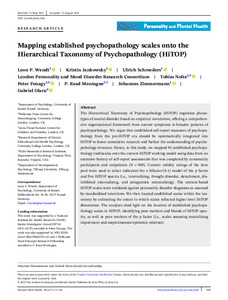| dc.date.accessioned | 2023-06-07T08:56:49Z | |
| dc.date.available | 2023-06-07T08:56:49Z | |
| dc.date.issued | 2022-09-26 | |
| dc.identifier | doi:10.17170/kobra-202306078185 | |
| dc.identifier.uri | http://hdl.handle.net/123456789/14800 | |
| dc.description.sponsorship | Gefördert im Rahmen des Projekts DEAL | |
| dc.language.iso | eng | |
| dc.rights | Namensnennung 4.0 International | * |
| dc.rights.uri | http://creativecommons.org/licenses/by/4.0/ | * |
| dc.subject.ddc | 150 | |
| dc.title | Mapping established psychopathology scales onto the Hierarchical Taxonomy of Psychopathology (HiTOP) | eng |
| dc.type | Aufsatz | |
| dcterms.abstract | The Hierarchical Taxonomy of Psychopathology (HiTOP) organizes phenotypes of mental disorder based on empirical covariation, offering a comprehensive organizational framework from narrow symptoms to broader patterns of psychopathology. We argue that established self-report measures of psychopathology from the pre-HiTOP era should be systematically integrated into HiTOP to foster cumulative research and further the understanding of psychopathology structure. Hence, in this study, we mapped 92 established psychopathology (sub)scales onto the current HiTOP working model using data from an extensive battery of self-report assessments that was completed by community participants and outpatients (N = 909). Content validity ratings of the item pool were used to select indicators for a bifactor-(S-1) model of the p factor and five HiTOP spectra (i.e., internalizing, thought disorder, detachment, disinhibited externalizing, and antagonistic externalizing). The content-based HiTOP scales were validated against personality disorder diagnoses as assessed by standardized interviews. We then located established scales within the taxonomy by estimating the extent to which scales reflected higher-level HiTOP dimensions. The analyses shed light on the location of established psychopathology scales in HiTOP, identifying pure markers and blends of HiTOP spectra, as well as pure markers of the p factor (i.e., scales assessing mentalizing impairment and suspiciousness/epistemic mistrust). | eng |
| dcterms.accessRights | open access | |
| dcterms.creator | Wendt, Leon P. | |
| dcterms.creator | Jankowsky, Kristin | |
| dcterms.creator | Schroeders, Ulrich | |
| dcterms.creator | Nolte, Tobias | |
| dcterms.creator | Fonagy, Peter | |
| dcterms.creator | Montague, Pendleton Read | |
| dcterms.creator | Zimmermann, Johannes | |
| dcterms.creator | Olaru, Gabriel | |
| dcterms.creator | London Personality and Mood Disorder Research Consortium | |
| dcterms.extent | 117-134 | |
| dc.relation.doi | doi:10.1002/pmh.1566 | |
| dc.subject.swd | Psychopathologie | ger |
| dc.subject.swd | Phänotyp | ger |
| dc.subject.swd | Psychische Störung | ger |
| dc.subject.swd | Klassifikation | ger |
| dc.type.version | publishedVersion | |
| dcterms.source.identifier | eissn:1932-863X | |
| dcterms.source.issue | Issue 2 | |
| dcterms.source.journal | Personality and mental health | eng |
| dcterms.source.volume | Volume 17 | |
| kup.iskup | false | |


